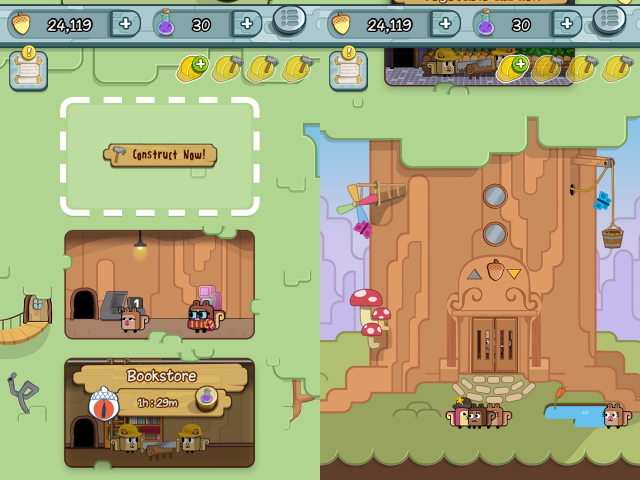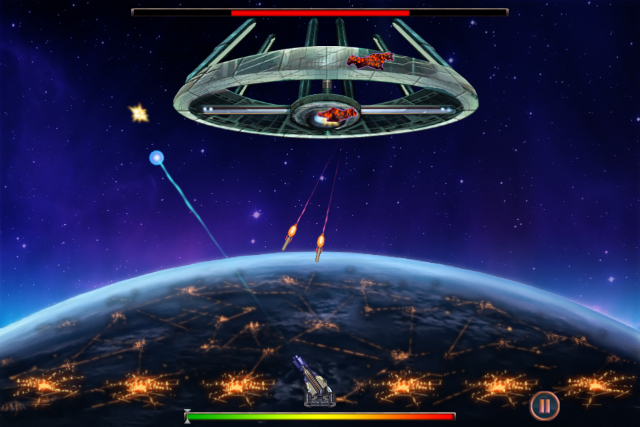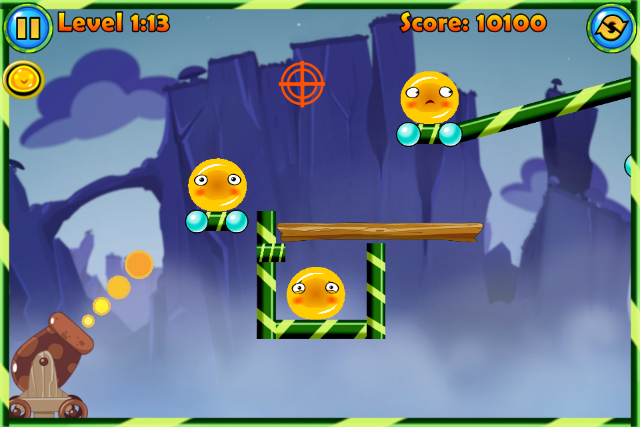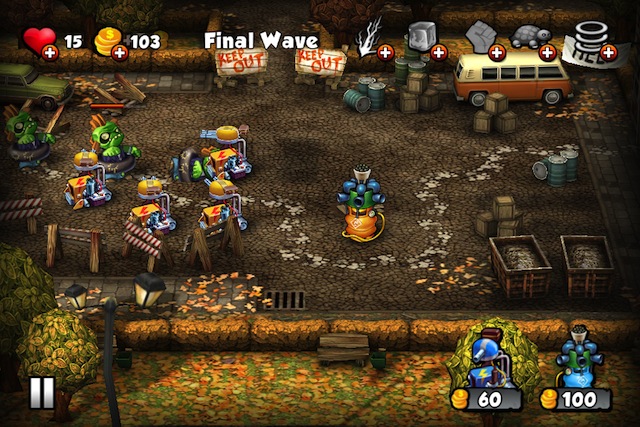Mobile Monday – Happy Squirrels, E.L.E. (Extinction Level Event), Jelly Cannon Reloaded, Dead Stop
You know what day it is? It’s Monday again and that can mean only one thing here at GodisaGeek.com: It’s time for another edition of Mobile Monday, the article where we take a look at four mobile games and let you know if they’re worth your time and money.
This week we’re taking a look at Happy Squirrels from Ipanema Games, E.L.E. (Extinction Level Event) from HugeMonster, Jelly Cannon Reloaded from Nickelodeon and Dead Stop from Techland.
Read on to find the full reviews of each game, but don’t forget to come back next week for more Mobile Monday reviews. While you’re here, if you have played any of the games listed, or even just want to come back once you’ve had a go to let us know how you got on, we’d love to hear from you in the comment box at the bottom of the page.
Get downloading and get playing!
Titles are available on iPhone and iPad unless specifically stated otherwise. If you like what you read, click the small black “App Store” button to load iTunes up and purchase the title!
![]() HAPPY SQUIRRELS:
HAPPY SQUIRRELS:
Time management apps and games are one of my biggest guilty pleasures when it comes to iOS gaming. They’re never usually designed with innovative gameplay in mind, usually revolving around actions that the player will repeat over and over again, however, I usually find myself coming back to them time and time again, completing the quests that the game is giving me or simply seeing how my new little civilisation is getting along. With Happy Squirrels, the latest game from Ipanema Games, things were exactly the same but, this time, instead of people that I’m going back to see over and over again, it’s little squirrels; who can say no to that?
The gameplay, as people would expect, revolves around building up the tree that all of the little squirrels live in. They’re going to need certain things, such as shops and entertainment establishments (how else are they ever suppose to be “happy” if they don’t have these things?) and it’s up to you to build these things for them using the acorns that you have at your disposal, by collecting them from the tree or from the buildings that you’ve already created. There are quests that you can work your way through, which involve upgrading buildings and such, but as long as you’re keeping the characters that live in your tree fulfilled then that’s all you’re ever going to be required to do.

Similarly to other games in this genre, the player can wait for things to happen in their own time, which usually takes a couple of hours, but if waiting for that much time isn’t an option then players can use real money to buy acorns and other in-game items in order to further the building of their tree at a more quicker pace. This is entirely up to the player, however, and players won’t ever be required to spend any of their hard earned money to further their status in the game; it’s entirely up to the individual player, a good deal of patience is all that’s truly “required”.
The controls are easy enough to enable all players who want to give it a go to be able to do so, nothing that you’ll be required to do takes skill or a quick finger, if you can point and touch a touch screen, and have the mental capacity to open the application in the first place, then you’re going to be able to play Happy Squirrels. The simplistic controls are in line with the rest of the game which, instead of being a complicated management system, is all simplified to allow even someone new to the genre to be able to sit down and get the ball rolling even on their first attempt.
Time management games are addictive to begin with, but slap some cute animals and a bright and colourful aesthetic on there and you’re bound to get people downloading and playing it; people of all ages too. The game is fun, and the little nuances and comedic elements, as well as the inherent gameplay, will keep people coming back for more and more time and again. The only reason I’d not recommend Happy Squirrels to people is if they have a bad history with getting a little bit too engrossed into this style of game, however, even for those people I’d still say to at least have a look. It deserves that. 

![]() E.L.E. (EXTINCTION LEVEL EVENT):
E.L.E. (EXTINCTION LEVEL EVENT):
There are some dangerously addictive iOS games available from the App Store, some of them ask you to do weird and wonderful things that you wouldn’t normally do, but giving you small rewards in the process that make you feel like you’re actually making a difference. Other games on the App Store, that still get people to keep on playing them, base their addiction purely on the player’s need to come back to the game in order to get a better score, or simply to get further in the game. E.L.E. (short for Extinction Level Event, and developed by HugeMonster) sits firmly in the latter category. Does the player’s need to come back to the game in order to be better at it make it a good game though?
The aim of the game – and what you’ll spend almost all of your time doing – is to protect the Earth from wave after wave of missiles sent towards our home planet by a slew of alien invaders. You have a single weapon at your disposal, a cannon that’s able to shoot the missiles out of the sky if you’re fast enough, but you’re the Earth’s only line of defence and if you allow six of the planet’s cities to be demolished via missile attack then it’s game over, the extinction of the human race has occurred and you’re going to have to give it another go, and there’s always the chance for “just one more go”, that’s what’s going to keep people coming back for more. Good luck next time soldier!

The ultimate goal that each player is striving towards is to survive as many waves of enemies as you possibly can, once those cities are destroyed you’ll be starting the whole thing again from scratch. The major downside of E.L.E. is the sheer amount of repetition that you’ll come across while you’re playing. There are only three types of enemy spacecraft that the player will be tested against and as soon as the third has been defeated, the while cycle starts all over again. Granted, there’ll be more missiles the second and third times around but the basic “end boss” is exactly the same and is defeated using the same tactics. For a game where it’s relatively simple to get to wave 10, where you’ll have seen the same bosses three times already, things start to get very old, very quickly.
The controls of E.L.E. are easy to grasp, as you’ll only need to tap the area of the screen where you want the missile to explode. The hardest aspect to get your head around is the fact that the missile will always explode where the player touches on the screen, even if it has to pass through other objects to get there. This takes a little bit of the tactical element out of placing a missile path but once you get used to it, as well as getting used to the fact that you’re going to have to tap on the screen where the missile is going to be, not where the missile currently is, you’ll be a master of the controls without too much of an issue.
E.L.E. is a game that’s at least worth a look, especially if you like wave based games and don’t mind about the constant repetition. For most people, the amount of times you come across the same enemies, in the same patterns, is going to be an issue and is a problem that stops E.L.E. from being anything more than simply average. This is a shame too, as the controls are intuitive and the visuals are relatively pleasing to the eye; too bad the gameplay doesn’t match up to them. 

![]() JELLY CANNON RELOADED:
JELLY CANNON RELOADED:
When you first see the name of Jelly Cannon Reloaded, the new game from Nickelodeon (yes, THAT Nickelodeon), I’d be surprised if anyone is jumping to have a go on the title. It’s not really a name that lends itself well to what the game is actually about, it’s not even really a name that suits the game; which most people will see once they have played the game. The icon for the game lets people know what they’re getting themselves in for a little bit better, as they’ll at least know that the game will involve cannon balls in some heavy way, but not a lot of people will be expecting the type of game that they’ll experience when they start the game up for the first time.
The gameplay revolves around having to use cannon balls to knock elements of the sunshine together to form a single entity. This might sound simple on paper, especially from an iOS game where you know you’re going to be using your fingers more than anything else, but after a couple of levels things start to change dramatically. The first couple of levels are simple enough, often requiring the player to just knock the smaller elements into the other and advancing on to the next level.

Some strange contraptions start to make themselves known later in the game, with a massive emphasis on physics and how these contraptions will react when hit with the cannon ball. Players will be forced to think outside the box with some of the later puzzles and it’s this element that will keep people coming back for more or, if you’re the type of player who finds it hard to turn puzzle games off in the first place, it’ll keep you playing long after you would have normally turned it off. The physics element of Jelly Cannon Reloaded is really the selling point of the game and sets it apart from other puzzle games currently on the iOS App Store.
The controls of Jelly Cannon Reloaded are exactly what you would expect, all the player needs to do is tap the screen where they want to fire a cannon ball, and the cannon will fire it in that direction. The further away from the cannon you tap, the faster and harder the cannon ball is fired. This element becomes important when you get to the areas of the game where the player needs to fire the cannon balls at a certain velocity in order to dislodge the items from their perch. If you don’t fire things fast enough then you’re not going to complete the level with as few moves as possible. All this means that you’re not going to get the three stars that everyone strives for when it comes to puzzle games on the iOS devices.
If you’re in the market for a new physics based puzzle game then Jelly Cannon Reloaded could surprisingly be the game that you’ve been looking for. It won’t seem that way when you first start the game, the first couple of levels feel a little bit slow, but once you get a couple of levels in, and start playing around with the different contraptions that the puzzle’s utilise, you’ll find yourself having so much fun that you’ll soon wonder where the hours have gone. It’s certainly worth a look at. 

![]() DEAD STOP:
DEAD STOP:
When you start up Dead Stop for the first time, you’re going to notice a couple of things. First of all you’re going to notice that the game is developed by Techland, the developers behind the Dead Island and Call of Juarez series of games, and you’re going to notice that the game is published by Chillingo, a publisher that has a hard time putting a foot wrong when it comes to mobile games. With those things in mind, most people will be expecting a mix of things, Techland’s AAA games have always had a mixed reaction and they’re not exactly known for their forays into the mobile app world, but we’ve been surprised before. Is this another of those times?
Dead Stop is essentially a tower defence game with zombies. Your objective centres around helping a mad scientist build and utilise weapons in an attempt to keep the encroaching living dead away from buildings full of trapped scientists. Let the zombies get to the door and it’s game over and you’ll be starting again from scratch. What makes Dead Stop a little bit different from most other tower defence games is the fact that the enemies have a predetermined path that they walk along. The usual tactic of forcing the creeps to zig-zag across the map in order to extend their time within your passageway of death isn’t going to work here; we’re going to have to think of something new.

You’ll constantly be given new weapons that you can try out, some of them will be fairly straightforward, such as the machine gun, while others are a little stranger, but definitely fun to use, such as the lightning you’ll use to take down some of the larger enemies (providing you’ve got some in your inventory). Everything works like you’re used to if you’re a regular tower defence player, with each of the weapons able to be upgraded and sold, and the variety of weapons on offer helps make the game much more interesting to play, and keep playing.
The controls consist of dragging different weapons, or towers onto the grid and placing them on areas that will light up while you’re dragging. Once you’ve dropped them you’ll be able to tap on them again in order to either upgrade the towers/weapons or simply sell them in order to fund some other tactic that you’ve got up your sleeve. There are a lot more reasons to touch the screen in Dead Stop than I’ve seen in other games of this genre, killed zombies will drop loot that needs to be picked up, there’ll be items that need to be cleared by tapping on them and certain special abilities are selected from the top of the screen too. That being said, it’s a simple game to get into and while it may seems that you’ve got to spin a lot of plates at the same time in order to get anywhere, it’s not actually a difficult game to play.
We’ve seen a lot of tower defence games here on Mobile Monday but Dead Stop is honestly something slightly different. It’s got enough of the charm and gameplay elements of a classic tower defence game to pull the hardcore crowd in, but it’s got the impressive visuals, a slightly simpler interface and genuinely funny moments required to bring in a new crowd. Dead Stop is a game that I can see myself playing for quite a long time to come and, if you give it the chance, I’m sure most of you will too. 





